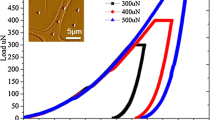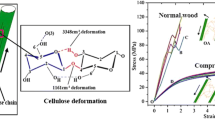Abstract
The relationship between microscopic compression failure lines and crack-nucleation is reported. Static and reversed cyclic bending load was applied to the specimens made from wood of Agathis species (Agathis sp.). The maximum subjected load was ±450∼650 kgf/cm2. The observation of the microscopic compression failure line and cracks nucleated at the root of the specimen was made every half cycle of load.
The microscopic compression creases nucleate at the tip of the notch on the one side face of the specimen in the compression cycle. The length of the microscopic compression creases shortened in the tension cycle. This is because the microscopic compression creases are stretched parallel to the cell axis. In the next compression cycle, the microscopic compression, creases appear again. After repeating these processes several times and when the shape of the microscopic compression creases has not yet recovered to its original shape a large part of the microscopic compression creases change into cracks. In other word, the cracks nucleate. Mostly, the tip of the microscopic compression creases preceeds the tip of the cracks. The microscopic compression creases and the cracks propagate by steps, and after repeating these processes several times failure of the specimen occurs. The cracks nucleate in the compression cycle and sometimes in the tension cycle too. The cracks follow microscopic compression creases. The microscopic compression creases and the cracks run at nearly right angles to the cell axis.
Zusammenfassung
Es wird über eine Beziehung zwischen mikroskopischen Stauchungslinien und Bruch-Initiierung berichtet. Zyklische statische Biegebelastung wurde auf Holzproben aus Agathis sp. angewendet. Die Höchstlast betrug ±450 bis ±650 kg/cm2. Die mikroskopischen Stauchungslinien und Brüche wurden nach jedem halben Lastzyklus beobachtet. Die Stauchungsfalten treten zuerst am Anfang der Einkerbung an der Oberseite der Probe während der Druckphase auf. Während der Zugphase verringert sich ihre Länge, weil die Stauchungsfalten parallel zur Zellachse gedehnt werden. Im nächsten Druckzyklus erscheinen die Falten wieder. Nach mehreren Wiederholungen und wenn die mikroskopischen Stauchungsfalten nicht wieder den ursprünglichen Zustand annehmen, wandeln sich die Falten in Mikrobrüche. In der Regel geht die Entstehung von Stauchungsfalten der Entstehung von Brüchen voran. Die mikroskopischen Falten und Brüche vermehren sich schrittweise, bis nach mehreren Wiederholungen der Bruch der Probe erfolgt. Die Mikrobrüche entstehen in der Druckphase, zuweilen auch während der Zugphase. Die Mikrobrüche entstehen aus den Stauchungsfalten. Beide sind senkrecht zu den Zellachsen ausgerichtet.
Similar content being viewed by others
References
Dinwoodie, J. M. 1978: Failure in Timber. Part 3: The Effect of Longitudinal Compression on Some Mechanical Properties. Wood Sci. Technol. 12:271–285
Furukawa, I. 1978: Optical Microscopic Studies on the Longitudinal Tensile Failure of Notched Microtome Sections. Mokuzai Gakkaishi 24(9):598–604
Imayama, N. 1987: The Fatigue of Wood. Part 4: The propagation of fatigue cracks in notched specimens. Mokuzai Gakkaishi 33(6):457–463
Imayama, N. 1988: The Fatigue of Wood. Part 6: Fatigue crack-propagation of cracked specimens. Mokuzai Gakkaishi, 34(11):896–903
Kaneda, T.;Furukawa, I.;Sakuno, T.;Kishimoto, J. 1988: Studies on Safety in Timbers and Woody Materials. Part 2: The Effect of Precompression on Mechanical Properties of Konara Wood (Quercus serrata Thung.). Bull. Tottori Univ. Forest. (Japan) 17:171–178
Keith, C. T. 1971: The Anatomy of Compression Failure In Relation to Creep-Inducing Stress. Wood Science 4(2):71–82
Kitahara, R.;Tsutsumi, J.;Matsumoto, T. 1981: Observations on Cell Wall Response and Mechanical Behavior in Wood Subjected to Repeated Static Bending Load. Mokuzai Gakkaishi 27(1):1–7
Kučera, L. T.;Bariska M. 1982: On the Fracture Morphology in Wood. Part 1: A SEM-Study of Deformations in Wood of Spruce and Aspen Upon Ultimate Axial Compression Load. Wood Sci. Technol. 16:241–259
Author information
Authors and Affiliations
Rights and permissions
About this article
Cite this article
Imayama, N. Relation on microscopic compression creases and crack of wood under static cyclic bending load. Holz als Roh-und Werkstoff 52, 49–56 (1994). https://doi.org/10.1007/BF02615019
Issue Date:
DOI: https://doi.org/10.1007/BF02615019




